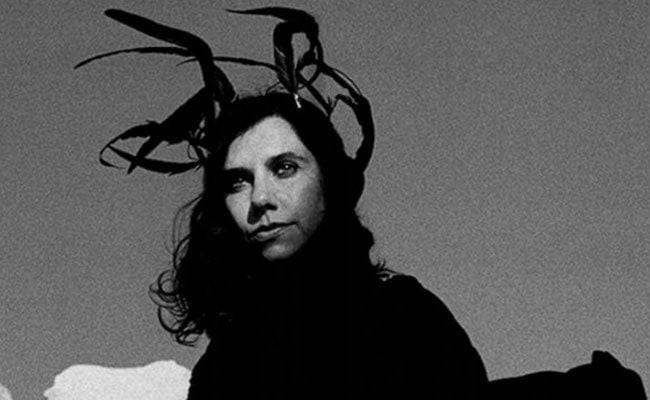
As Abigail Gardner implies in her introduction to PJ Harvey and Music Video Performance, PJ Harvey enjoys a status approaching that of national treasure in the United Kingdom. With one platinum and two gold albums to her credit, as well as nine Top 40 singles and, uniquely, two Mercury Music Prizes (for Stories From the City, Stories From the Sea in 2001 and Let England Shake in 2011), it was no surprise to find her awarded the MBE (Member of the British Empire) in 2013 for services to music. If her work has not travelled well — three albums that crept into the lower reaches of the Billboard Top 40 and a couple of hits on the Alternative Songs chart in the mid-’90s represent her principal commercial successes in the United States — there’s no doubting her towering status among musicians: individuals as stylistically diverse as Chino Moreno and Kurt Cobain cited her as influential.
Gardner’s starting-point is Harvey’s kaleidoscopic subject matter, which has included the nature of memory, eroticism, and conceptualisations of national consciousness among others at various times over the last quarter-century. One of the book’s main strengths is its impressive command of the scholarly literature. Gardner contextualises Harvey’s output against a rich patchwork of theory by academics such as Sheila Whiteley, whose pioneering work on gender and youth in popular music continues to resonate; and, in the field of music videos, Carol Vernallis, whose imperious Experiencing Music Video: Aesthetics and Cultural Context (Columbia University Press, 2004) remains a key reading.
PJ Harvey and Music Video Performance‘s principal investigative mechanism is the detailed critical analysis of ten of Harvey’s videos. Arguably the most important contribution during Harvey’s early career was her infamous song about infanticide, To Bring You My Love’s lead single, ‘Down By The Water’ (1995), the video for which benefits from a lengthy analysis here. Gardner’s insightful feminist reading reveals unexpected incongruities: the connotations of “diva-ness” (p. 1) are undermined by the wearing of a huge wig entirely at odds with the imagery (and indeed, as Gardner perceptively points out, Harvey’s usual live performance practices at the time), and Harvey’s positioning in the video — wearing the same clothes throughout, she simultaneously assumes the role of mother and drowned child –further underscores the vast gulf between the connotative text and the denotative text. Harvey acts as the ‘deathly ‘diva” (p. 124), as Gardner puts it, the images of her underwater evoking artistic depictions of Shakespeare’s Ophelia.
Referencing Vernallis, Gardner persuasively argues that this is a product of the inherent ambiguities of music video as a genre. The point is again emphasised during the discussion of ‘The Letter’ (2004). This ‘audiovisual assault’ (p. 85) is a scattershot melange of Americana in a succession of split-second snippets of footage of Harvey and the Californian landscape in which, it is suggested, Harvey inhabits the roles of voyeur and visitor. But the text is far more complex. One suspects that Gardner’s reach exceeds her grasp here; in the space of half a dozen pages, the video for ‘The Letter’ is claimed to be a narrative on Harvey as tourist, but also as a way of inscribing Harvey’s story on the cultural landscape, an adjunct to the song’s function as ‘a paean to letter-writing’, and an exploration of her relation to mythology. If one accepts (pace Barthes) that the author, though not at all well these days, is not quite dead, it stretches credulity somewhat to imagine that Harvey had all of these meanings in mind when she made the video.
In terms of subject, there are some odd choices. To Bring You My Love’s third single, ‘Send His Love to Me’ (1995), is a curious omission, especially as the setting for the song’s video — a dusty scrubland redolent of the American West, complete with tumbledown shack and joshua tree — so neatly supports Gardner’s contention that Harvey’s work provides a nexus for ‘national and transatlantic musical, visual and lyrical heritages’.
There is also the occasional puzzling omission in the textual analysis. The imagery of the golden shoes, so prominent in the aforementioned video for ‘Down By the Water’, are rightly situated within what Gardner describes as a whole ‘wardrobe of dancing shoes… part of a collective cultural memory bank’ (p. 125), and she compares them to the red shoes of Powell and Pressburger’s eponymous film (1948), ‘Oh Dem Golden Slippers’ (a song, Gardner notes, that is evocative of heterosexual marriage), and so forth.
Yet if their ultimate meaning in the video is as ‘Cinderella shoes, filled with the prospect of a heteronormative bliss that… is ruined’, surely one of the more obvious points of departure in recent years is David Bowie’s ‘Let’s Dance’ (1983), the video for which was analysed by Deborah Holdstein in a pioneering 1984 article. It famously features a group of Aboriginals encountering a pair of red shoes in the outback: one of them puts them on and, along with a boy, she travels to the big city, and there lives a life imbued with all the trappings of Western consumerism that ultimately denies them both inner fulfillment.
Even closer in symbolism are the golden high heels worn – and brandished – by Harvey’s near contemporary Tori Amos in the video for ‘Crucify’ (1992), a Top 20 hit in the UK. Like ‘Down By the Water’, ‘Crucify’’s video also features the singer diving into water fully clothed — in this case, a filled bath — and accompanies a song that also features a tale of love between a daughter and a parent.
To focus on such minor quibbles, however, would be to detract from the book’s manifest contribution to the field, not only in terms of Harvey’s understudied output, but more generally as a critical examination of videos. In both senses, PJ Harvey and Music Video Performance stands as a fine addition to the growing body of literature on music video performance.

